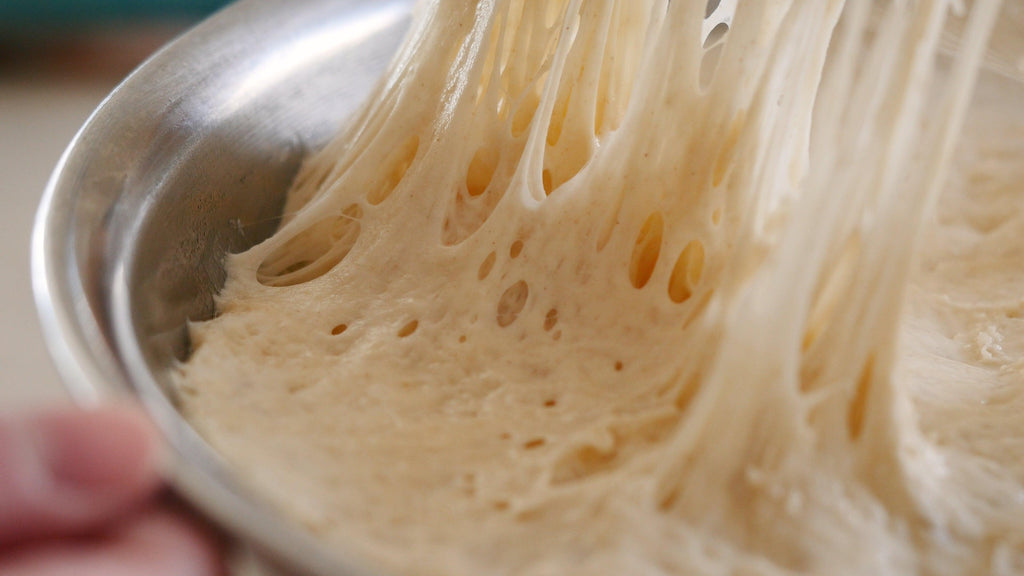Gluten & Protein in Baking
Have you ever noticed that flours have different protein percentages? What do these percentages mean? Why do these percentages matter?
To understand why protein matters, it’s important to understand what gluten is. We find that while most people attribute gluten to making you fat,
and when asked what gluten is, they aren’t able to tell you.
Simply put, gluten is a family of proteins found in many grains. Wheat contains two large proteins - Glutenin and Gliadin. Dough gets its strength and elasticity from glutenin, a large, complex, protein with high water absorption, and its ability to rise from gliadin, a protein with low water absorption. When baking, these two proteins combine to make a network that is responsible for the structure and texture of baked goods! However, it's important to note that not all flours have the same ratio of glutenin and gliadin. In our flours, the ratio is determined by the desired characteristics of the flour! For example, when glutenin and gliadin are equal, your dough will be very extensible, but when there is more glutenin, your dough will be more elastic and have more gas retention.
To understand exactly how this works, let’s walk through the process!
1. When flour becomes hydrated (when water is added) the glutenin and gliadin combine to create gluten. As you mix your dough, the gluten forms a webbed network. Have you ever opened your dough and seen something like this?

While you may not need to heavily mix your dough for the gluten to develop (hello, no-knead doughs!), mixing does allow the flour to more evenly absorb the water and it allows the protein chains (gluten!) to grow and create a network that is strong, elastic and extensible.
2. After mixing your dough, the gluten development continues. As the dough rests, enzymes have more time to act, meaning more molecules stick together and gluten chains continue growing and developing. The forming gluten network traps the gas bubbles during fermentation which helps dough rise! This is how dough can stretch and hold it’s shape!
So how do I know how the gluten development of my dough is going?
A tip for checking gluten development is to perform a windowpane test. This is when you take a small piece of dough and you stretch it gently between your fingers or hands so it becomes thin and translucent without breaking.

If your dough breaks or doesn’t stretch to become thin enough to see through, you may need to knead a bit longer.
3. If you perform a bulk ferment, tension will be created during shaping that will help the dough to further expand and tighten. When the dough is shaped, it ferments for a final time. This final stage of proofing is when the most carbon dioxide production occurs.
4. When baking, the dough will rise even more, so it must be strong enough to contain the gas it has trapped inside (per step #2!). However, if you don’t see a rise in baking, or if your product deflates in the oven, there are a few reasons why this may have happened. One of these reasons is over proofing which is when your dough ferments for too long and the trapped carbon dioxide becomes too powerful for the gluten network to contain. As the gluten network weakens, it releases the gas and deflates the dough.
Okay, so gluten is a protein that makes dough stretch, hold it’s shape, and rise, right?
Right! So, protein is important because it determines the gluten structure. It determines how strong your dough will be! Protein percentages are great because they provide guidelines, but always remember that it's not the quantity of protein that matters, but rather the quality.
Okay, so in general, when do you want high protein vs moderate vs low?
To determine what protein percent you should look for, you need to first determine what it is you want to make!
Baking Bread = high protein. You want a strong gluten network that can hold the shape of the loaf and allow it to rise.
Baking Pizza = moderate to high protein. Depending on the style, you’ll want a soft yet strong dough.
Baking Pastries = lower protein. You want a tender flour that won’t produce a ton of crumbs.
Baking Cake = low protein. You want a delicate flour that will create light and fluffy cakes that melt in your mouth.
Gluten gets a bad rap! While it is possible that eating bready foods and eating gluten can negatively impact digestion, it’s also important to consider other factors that could be the cause. We recommend always consulting your doctor when you experience pain, discomfort, or issues with digestion and we also recommend looking into and understanding additives that are often added to flour. Gluten is just a network of protein strands holding in gas, so next time you want to bake something, consider the protein percent of your flour and enjoy!

